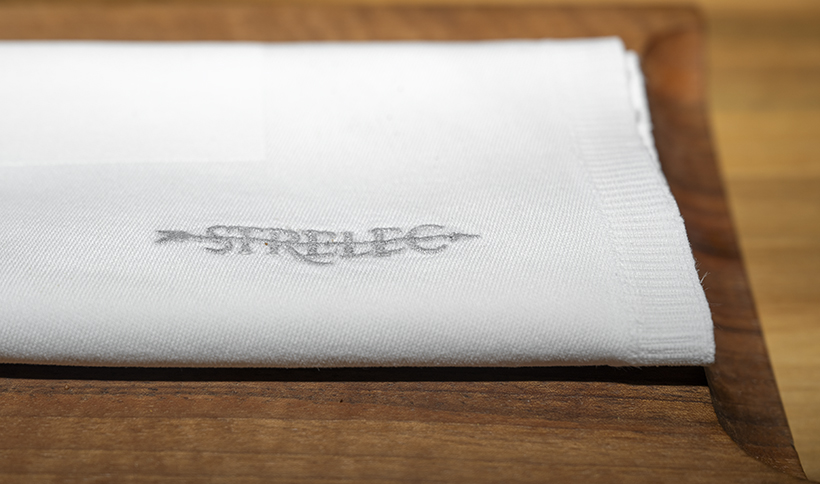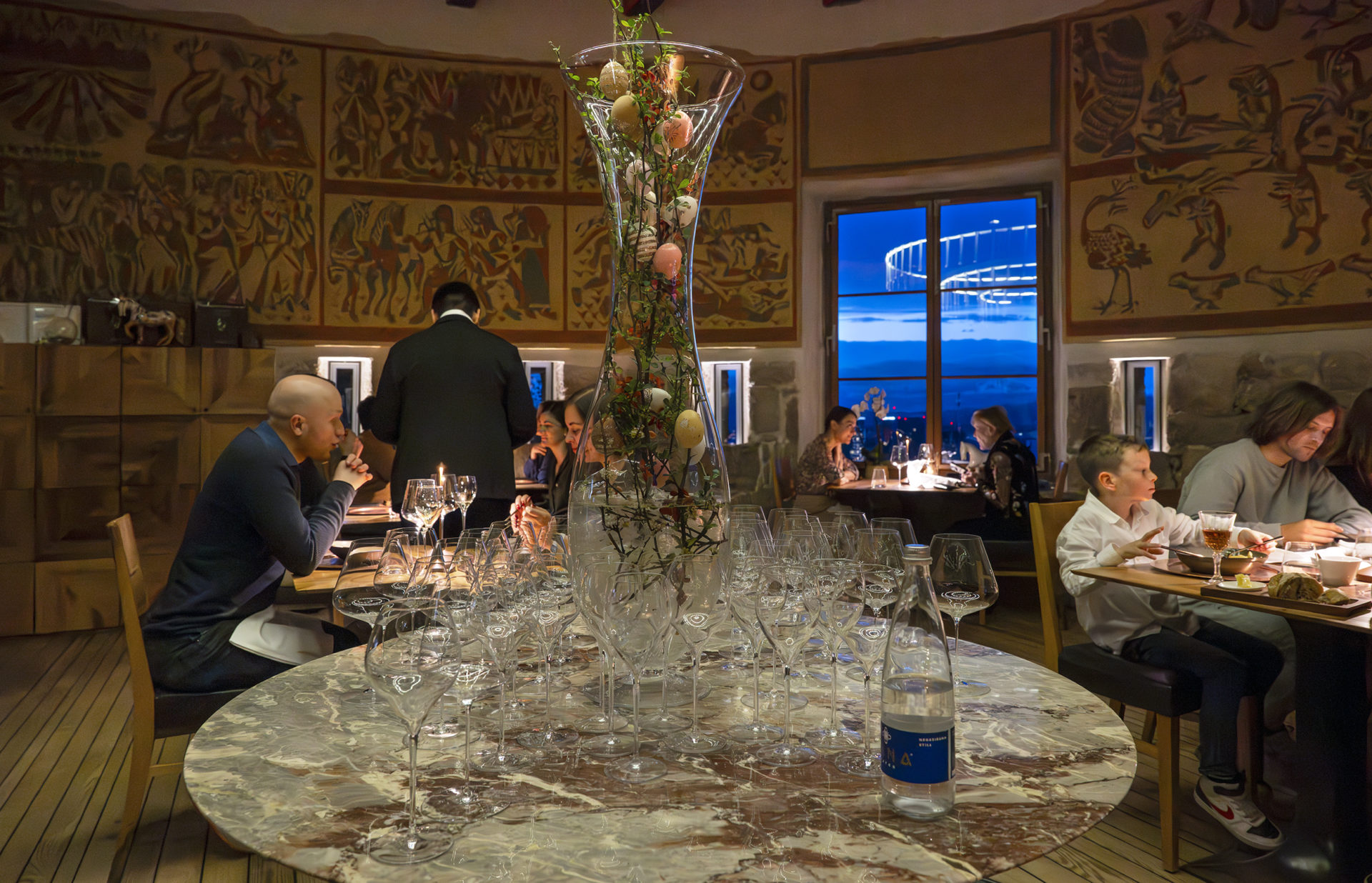Ljubljana Castle is the most visited attraction in Slovenia. A historic monument towering over the city, it’s also used for weddings and cultural events. Standing right next to the entrance, the 15th-century Archers’ Tower hosts one of the city’s best restaurants: Strelec (literally “the archer” in Slovenian), run by chef Igor Jagodic.
Jagodic’s story will sound familiar to those who read my recent posts on Croatia’s Stars. Having dreamed of being a cook since childhood, he completed vocational school and found a job at Brdo Castle (the Slovenian government’s main venue for diplomatic meetings and other government-sponsored events) under celebrated chef Andrej Goljat. Thanks to his hard work and talent, Jagodic became the chef de cuisine at several restaurants in Bled while still in his twenties. To take his cooking to the next level, he then decided to travel abroad. He attended Alain Ducasse’s culinary school in Paris, and interned at René Redzepi’s Noma and Nils Henkel’s Gourmetrestaurant Lerbach, with 3 and 2 Michelin stars, respectively. He came back to Slovenia to the newly-opened Strelec restaurant in 2012, putting his learning into practice to build its reputation as one of the best in the countrry. He was recognized as Chef of the Year 2019 by Gault & Millau, and received a Michelin star in 2022.
Check out this video to see the chef in his natural habitat and hear his philosophy in his own words:
Jagodic focuses on flavors and local, seasonal ingredients. He supposedly visits the city marketplace at the foot of the castle hill regularly. While he creates a sophisticated menu, the many components in each dish always revolve around one or two ingredients, such as one type of vegetable prepared in multiple ways. Some dishes, like his cauliflower in three versions with mayonnaise and truffles, are true hits that have been offered for several seasons. “I can’t improve them any further, I’d only spoil them with changes,” he says. He also doesn’t hesitate to serve vegetables for dessert.
Time to enter the restaurant. The round room at the top of the Archers’ Tower isn’t very big, but it offers a panorama of the city; I hear that a terrace provides even better views in the summer. All around the tower’s interior, sgraffito murals designed by architect Boris Kobe and painter Marij Pregelj in the 1950s depict Slovene folk stories or songs featuring fantastic beasts and characters: Povodni Mož (the Water Man), Lepa Vida (Beautiful Vida), Desetnica (The Tenth Daugther), Mlada Zora (Young Zora)…
Strelec offers menus consisting of 5, 7, or 9 courses. I’m opting for the 7, which means I’ll be eating three appetizers, two mains, and two desserts, complemented by as many wines. But as in any self-respecting Michelin restaurant these days, the dinner starts with several rounds of amuse-bouches. Being a no less self-respecting Michelin patron, I order an additional glass of sparkling wine to pair with them.
First comes a salvo of three treats. On one plate, a gougère filled with lentil and black sesame cream, topped with black sesame dust and roasted garlic mayonnaise. Somehow, outside of its actual region of origin, the gougère has come to designate various kinds of savory choux puffs, often with random fillings. Once one accepts that this has nothing to do with the real deal, it’s an interesting idea.

A second plate features a double ticket: a classic chicken liver mousse glazed in red beet juice, topped with gold leaves and resting on a cracker; and half an onion pickled in dark beer and stuffed with venison pâté, onion crumble on top. Both are good, but the latter is tastier and more original than the former. The classic French pâté goes well with the minimally cooked onion, which adds some crunch.
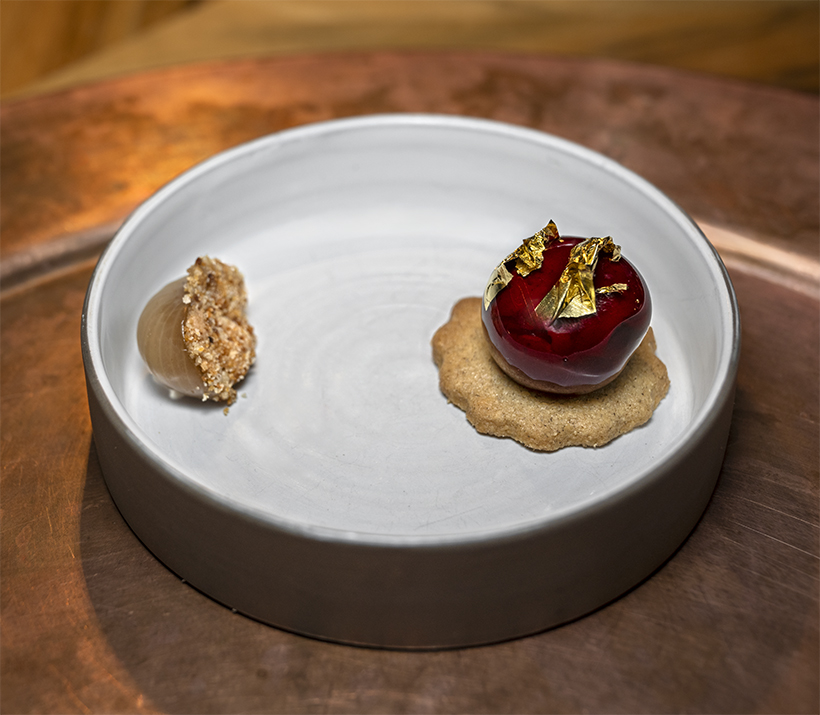
Another wave brings two more plates: smoked trout, trout roe, and pickled cucumber covered with espuma (not photographed), and a tiny crunchy taco with marinated trout, topped with horseradish mayonnaise and pickled ramson.
Both are quite classic pairings but very well made, with subtle flavors, the fish neither overly smoked nor marinated. After my dinner at Skarucna the previous night, this is the second time I’m being served trout.
My wine is the Podravje Zlata Radgonska Penina, golden sparkling wine from by Radgonske Gorice, a winery near the Austrian border that makes a lot of sparklers. This brut nature made with Pinot Blanc is pleasant enough but nothing to write home about.
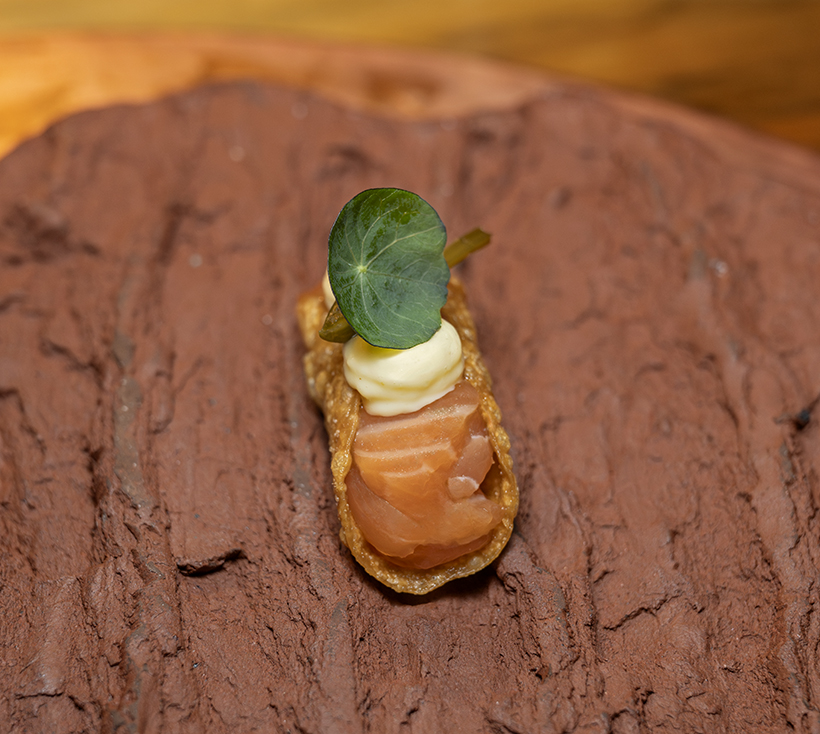
The restaurant makes its own sourdough bread and smoked butter (not photographed). The bread loaf is a little bit dense, but this seems to be the general style of Slovenian bread. The smoked butter tastes only mildly smoky.
The meal starts in earnest with a cold appetizer of marinated scallops, surrounded by macadamia cream and cilantro mayonnaise, served on a disc of puff pastry (though it’s more like a water cracker in my opinion), and topped with dehydrated cilantro dust and a citrus gel. The dish is finished tableside with citrus juice and olive oil. I think that the gel plus the juice makes for one too many citrusy ingredients and masks the other flavors. The scallops taste very good, though, and this is certainly a very pretty plate.
The dish is beautifully paired with a 2021 Furmint from Verus, in Styria. Called Šipon in Slovenia, this is a popular varietal in the northeastern regions of the country. The light-bodied, fresh white wine features notes of apple and apricot. A pretty good Furmint.
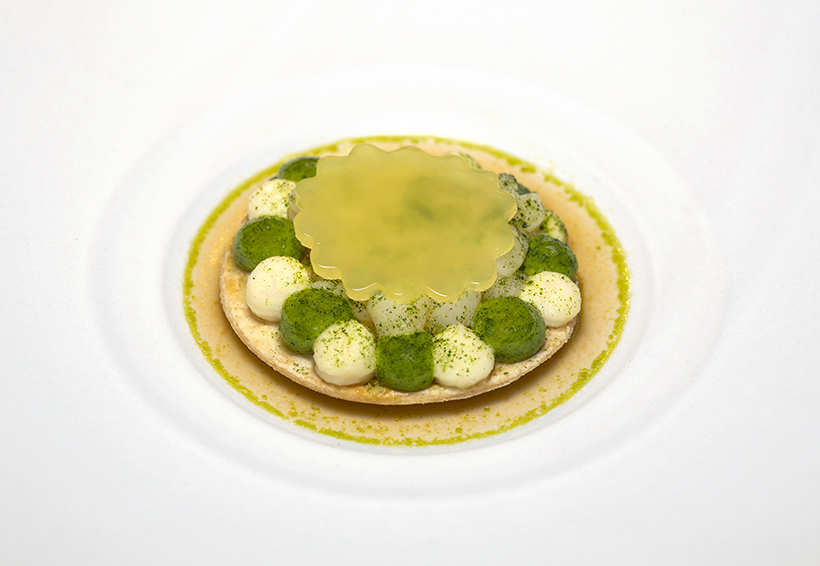
Next comes the chef’s famous dish of variations on cauliflower: a cream of roasted orange cauliflower and a poached egg yolk at the bottom, topped with fried cauliflower, cauliflower couscous, a crumble of hazelnut and truffle, and a rosette of truffle mayonnaise, with plenty of black truffle shaved on top. Cauliflower and truffle are a classic pairing, but there’s a great variety of textures and I understand why this became one of Jagodic’s signature dishes. I’m just wondering if the mayo is made with truffle oil, which would be sad, and in fact the mayo itself isn’t all that necessary to the dish. Note that this is the second dish I’m eating with a spoon, and it’s not always easy to cut the cauliflower without a knife.
The pairing wine is a 2021 Zelèn from Fedora, in the Vipava Valley. Zelèn is an indigenous varietal found mostly in the western part of Slovenia. The wine is the result of spontaneous fermentation with no temperature control and is bottled unfiltered. It boasts a fantastic natural wine nose of the kind that I like very much, acidic but at the same time very fruity with notes of honey and propolis. I get the same notes on the palate. This medium-bodied, surprisingly refreshing wine also goes very well with both the cauliflower and the truffle.
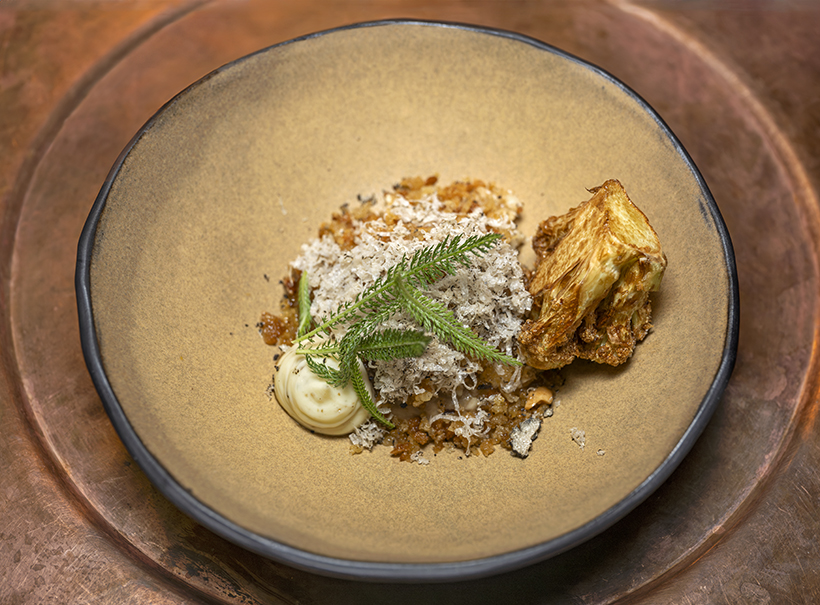
The third dish offers several preparations of onion and other alliums: a purée of white onion topped with roasted shallot and a cottage cheese dumpling, covered with a gel of onion vinaigrette with mustard seeds, scallions, dehydrated yeast dust, and a foamy dark beer and aged Jamar cheese sauce that pretty much covers everything else – since I forgot to take a picture before eating, just imagine the plate below covered with foam! There’s again a great variety of textures (and again no knife), this time with well-balanced tastes. The dumpling is like a soft round ravioli filled with cottage cheese and topped with a tart and slightly bouncy sheet of gel. The scallions bring some crispiness. The onions and the shallots add a touch of sweetness, and the aged cheese in the espuma add some saltiness. If I could taste it alone, the dark beer would doubtlessly be slightly bitter. A very good dish.
This is accompanied by a 2016 Malvazija from Montemoro, in the Primorska region (the Slovene Littoral). Malvazija, aka Malvasia, is an Italian variety that’s also quite popular in Istria and neighboring regions. A pioneer of biodynamic wine in Slovenia, Montemoro macerated this 2016 vintage with the skins for 11 days (hence its intense color), and aged it for 3 years in oak barrels. The resulting orange wine reaches a whopping 15 percent alcohol, which you don’t really feel. Yet somehow the nose (citrus and honey) is less pronounced or interesting than that of the previous wine.
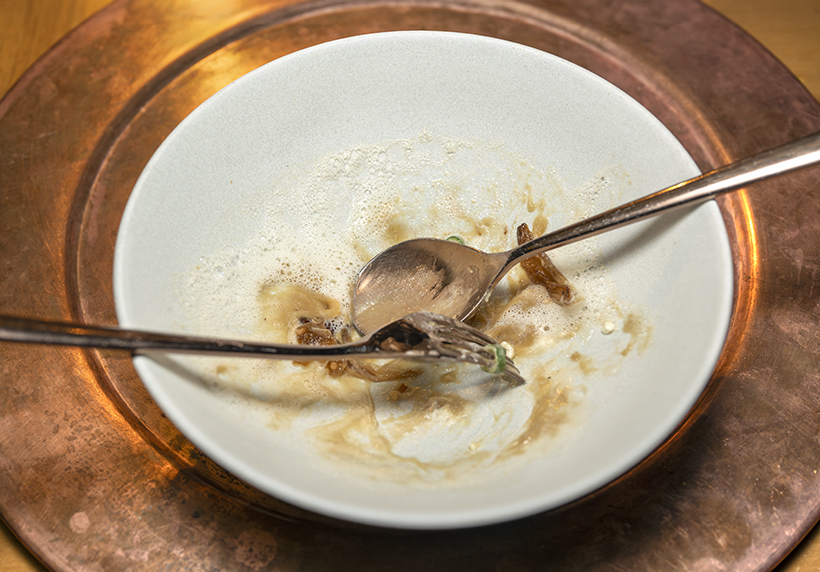
First main course – with a knife! Poached fillet of turbot, topped with lemon breadcrumbs, garnished with a green roll of Swiss chard, spinach, ramson, dandelion, and Adriatic prawns, and finished with a green herb oil and a brown butter sauce poured tableside. The turbot is very well prepared, maybe a bit masked by the lemon in the breadcrumbs or the sauce. I think the roll is an excellent idea with a nice combination of flavors, though maybe I would use slightly fewer leaves (I’m not crazy about Swiss chard) and more purée.
The fish is paired with an elegant 2020 Mulit Belo from Mulit in the famous Goriška Brda wine region, near the Italian border. This is a cuvée of four grapes, including three classic French varietals (Sauvignon Blanc, Chardonnay, and Viognier), and one typical of the region, Rebula (known as Ribolla in Italy, especially in the Friuli-Veneze region). The wine was matured in an amphora for ten months. The result is very opulent, with lime and vanilla notes, and happily for me it does not provoke the dry mouthfeel that I usually associate with amphora wines.
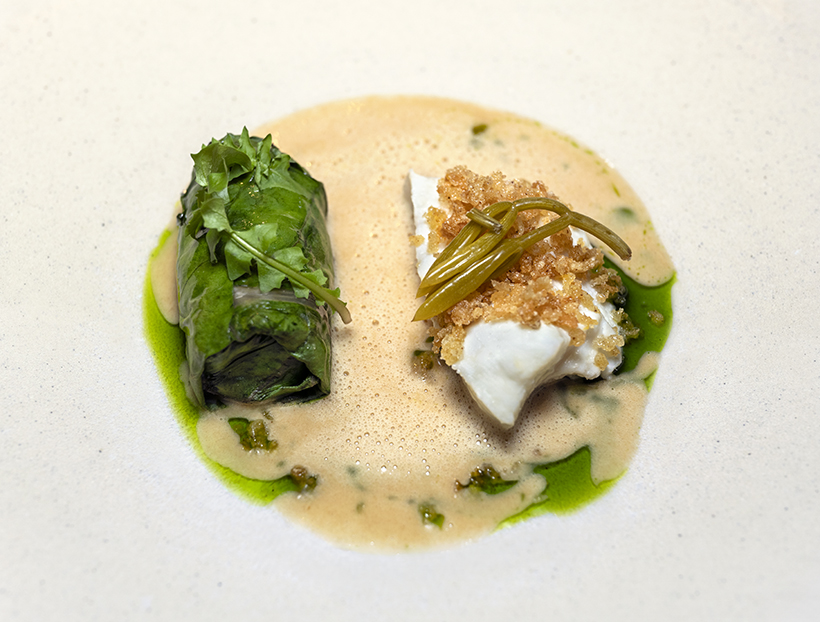
Our second main course is a beef and red beet combination. Beef sirloin and beef tongue (from Slovenian cattle) are served with pickled beet, a beet cream, a beet ravioli stuffed with polenta and oxtail, and redcurrant. The waiter finishes the dish with a sauce flavored with smoked bone marrow. It’s a very pretty plate with a nice variety of beef cuts. Beef and beet are a classic pairing for a good reason, and everything tastes exactly as it should. The tongue is very tender; I’ll always like ribeye more than sirloin, but the doneness is right; I can taste the oxtail in the ravioli and the smokiness and animal fat in the jus.
We’re now switching to red wine, with a 2012 Modra Frankinja from Dveri Pax in Styria. Modra Frankinja (aka Blaufränkisch) is a traditional varietal in the northeast of the country, producing fruity wines with notes of currants and blueberries. This wine is no exception but is more full-bodied than usual, thanks to two years of aging in barriques. The fruity notes are complemented by those of vanilla, chocolate, and black pepper. This older vintage is quite pleasant and not tannic at all.
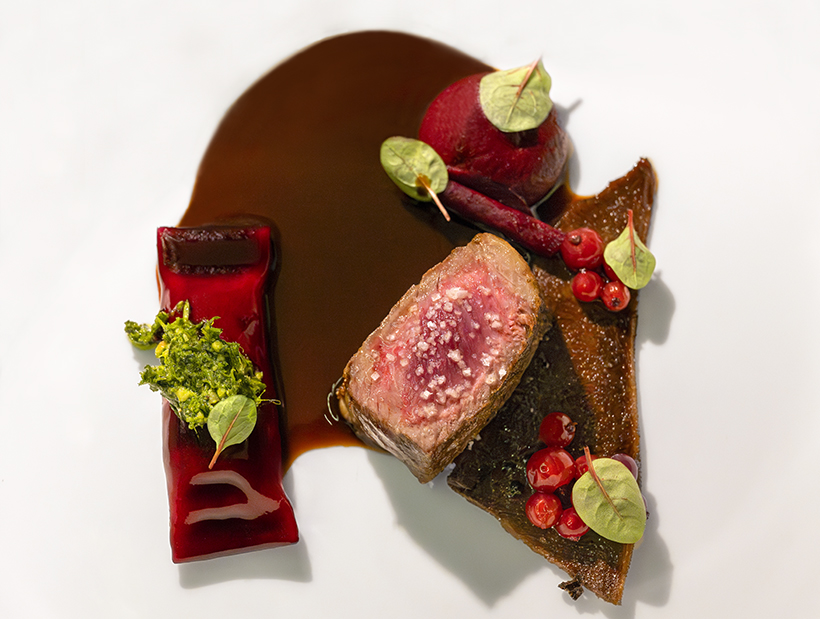
For pre-dessert, the chef offers combinations of carrot, mandarin, and sheep’s milk yogurt, across two plates. The first consists of a mandarin meringue filled with a yogurt espuma and mandarin sorbet, resting on a bed of carrot gel dice and ginger cream. The second is a small cube of carrot cake topped with mandarin yogurt cream. Again, we have a contrast of textures between the carrot gel, the mandarin meringue, and the ginger cream, and it’s a well-thought pairing of flavors, classic but a bit more off the beaten path when presented as a dessert, with ingredients that I remember seeing at the market. The carrot cake is just carrot cake, but it’s moist and soft.
This comes with a semi-dry 2021 Dišeči Traminec (aka Gewürztraminer) from Steyer in Styria, just a little farther to the north than the previous wine. Aged in stainless steel tanks, its light and aromatic, quite floral with a hint of grapefruit, perhaps. The floral notes in particular complement the food very nicely.
The principal dessert is built around hazelnuts, stacking a mousse of hazelnut gianduja, a bergamot cream, hazelnut ice cream, and a leaf made of hazelnut. This is an excellent dessert, and while everything tastes good, the hazelnut ice cream deserves a special mention. Likewise the bergamot cream, likely made with yogurt, which adds a touch of acidity.
We finish the wine pairing with a sweet 2018 Klarnica Passito from Sveti Martin in the Vipava Valley. As the name suggests, the wine is made from the Klarnica varietal, a Slovenian autochthonous grape mostly found in that region, in the passito style, with a late harvest that finishes in late October or early November. The wine is kept for one year in oak, and the result is very sweet, very intense, and fruity (raisin comes to mind, which is no surprise with the passito method), though lacking a bit of acidity. It reminds me of late harvest wines from upstate New York, but with a different varietal.
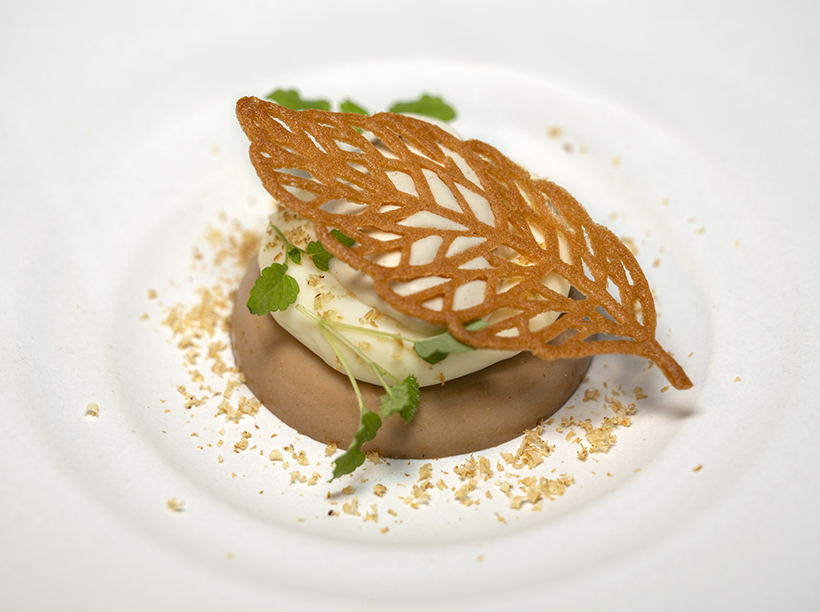
We conclude the meal with petits fours: a sablé with a combination of lime, chamomile, and honey; a warm canelé; and a chocolate-coffee tartlet with caramel. With these classic flavors of herbal tea, chocolate, and coffee, it’s a good way to end dinner.
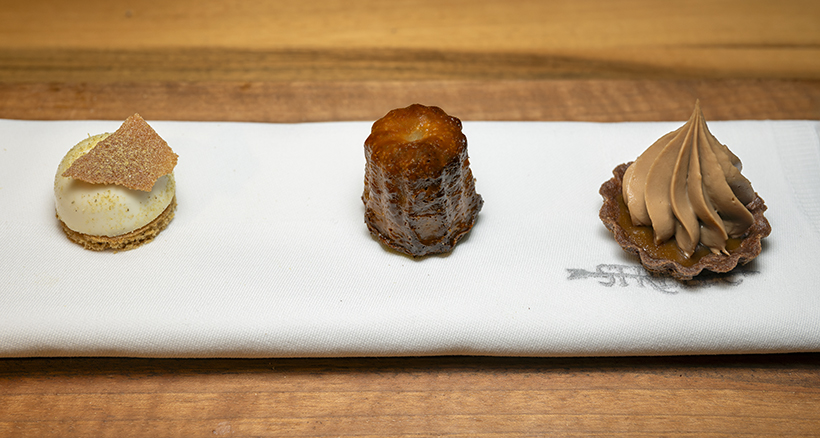
In his tasting menu, Jagodic touches on a lot of what constitutes Slovenian cuisine: freshwater fish, seafood, beef, game meat, but also root vegetables, Swiss chard, and cauliflower. Since he attributes so much importance to his ingredients, I decided to revive my old tradition (last seen almost 3 years ago here) of listing every ingredient that appeared on the menu. See the results below, roughly grouped into categories.
Jagodic excels at contrasting textures, and in his efforts to construct a dish around one or two products, focuses a lot on food pairings. Many of those err a bit on the classic side (trout and horseradish; cauliflower and truffle; beef and red beet), and the use of too many Michelin-darlings (turbot, scallop, steak, truffle) reveals a certain adversity to risk. Then there’s the three dishes finished tableside in one meal, turning a Michelin tradition into more of a gimmick, and the strange insistence on serving food without a knife (which we’ll also encounter in other Slovenian restaurants). Still, everything is well executed and tasty, and the quality wine pairings provide a varied introduction to the country’s production. I’ll gladly give Strelec a repeat visit if my adventures bring me back to Ljubljana. But one last thing, to the front of house: please stop playing Frank Sinatra.
| beef sirloin, beef tongue, bone marrow, chicken liver, oxtail, venison |
| prawn, scallop, trout, trout roe, turbot |
| carrot, cauliflower, cucumber, dandelion, garlic, lentil, onion x2, red beet x2, ramson x2, scallion, shallot, spinach, swiss chard |
| black truffle |
| chamomile, cilantro |
| black sesame, dehydrated yeast, ginger, horseradish, mustard seeds |
| herb-infused oil, mayonnaise x3, olive oil, vinegar |
| butter x2, egg yolk, Jamar cheese, sheep’s milk yogurt, skuta |
| bread, breadcrumbs, cracker x2, polenta |
| bergamot, citrus, lemon, lime, mandarin |
| hazelnut x2, macadamia |
| honey, caramel, coffee |
| dark beer x2 |
